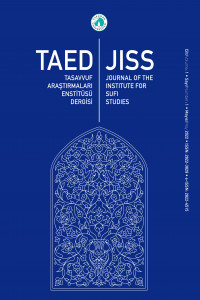Ekberî Gelenekte Tasavvuf ve Aklî Tahkîk
Ünlü Endülüslü sûfî İbn ‘Arabî’nin (ö. 638/1240) önde gelen bazı takipçilerinin felsefe disiplininde derin bilgi sahibi oldukları gerçeğine rağmen Ekberî gelenek, Batı akademisinde genellikle, terimin olağan anlamında, bir felsefî ekol olarak görülmez. Bunun nedeni İbn ‘Arabî takipçilerinin, felsefenin esas problemlerini, tasavvufî ve dînî sembolizm (ki burada hepsi olumlu anlamda anlaşılmaktadır) aracılığıyla ele alma eğiliminde olmalarıdır. Dolayısıyla bu makalede, bütünleşik bir felsefî görünüm olarak İbn ‘Arabî ekolünün öğretilerini uygun bir biçimde ortaya koyabilmek için, ekolün mensuplarının sembolik formüllere yaptıkları vurgunun, büyük oranda, iyi bilinen rasyonel kavramları daha kolay anlaşılabilir ve somut bir dille anlatma amacından kaynaklandığını ileri süreceğim. Elbette bu, dînî sembolizm veya tasavvufun, felsefeyi, filozof olmayanlara erişilebilir kılmak için kullanıldığına yönelik basite indirgenmiş görüşü tasdik etmek anlamına gelmemektedir. Aslında, İbn ‘Arabî ve takipçileri, hem tasavvuf hem de felsefeyle ilişki kurarak, felsefî dilin kendisinin de pek çok yönden dînî veya tasavvufî hakîkatlerin sembolik bir temsili olduğunu ileri sürer. Bununla beraber onların bakış açıları genellikle bir çeşit felsefî tasavvuf olarak nitelendirilir ki bu, bir açıdan, aklî sorgulama ve tasavvufun aynı madalyonun iki farklı yüzü olduğu görüşünden beslenen, felsefe ve tasavvufun eşsiz birlikteliğinden doğan belirli bir teknik dil oluşturmaktadır.
Anahtar Kelimeler:
İbn ‘Arabî, Ekberî gelenek, tasavvufî, Ibn ʿArabī, Western scholarship, symbolism
Mysticism and Rational Inquiry in the School of Ibn ʿArabī
Despite the fact that some of the main followers of the famous Spanish Muslim mystic Ibn ʿArabī (d. 638/1240) were well-versed in the discipline of philosophy, the school of Ibn ‘Arabī is often not regarded in Western scholarship as a philosophical school in the usual sense of the term. This is because Ibn ʿArabī’s followers tend to tackle the central problems of philosophy through the medium of mystical and religious symbolism (all here positively understood). In order to properly present the teachings of the school of Ibn ʿArabī as a unified philosophical perspective, therefore, I will argue that their emphasis upon symbolic formulations are largely a means by which they can present well-known rational concepts, but in accessible and concrete language. This is not, of course, an endorsement of the simplistic view which says that religious symbolism or mysticism is merely philosophy clothed up and made accessible to non-philosophers. In fact, through an engagement with both mysticism and philosophy, Ibn ʿArabī and his followers would also like to suggest that philosophical language is itself in so many ways a symbolic representation of religious or mystical truths. Nevertheless, their perspective is usually characterized as being a kind of philosophical mysticism, as it forms a unique hybrid of both philosophy and mysticism in a particular technical language largely informed by the view that, from one perspective, rational inquiry and mysticism are two sides of the same coin.
Keywords:
Ibn ʿArabī, Western scholarship, symbolism,
___
- For Ibn ʿArabī’s life and teachings respectively, see, inter alia, Claude Addas, Quest for the Red Sulphur: The Life of Ibn ʿArabī, translated by Peter Kingsley (Cambridge: Islamic Texts Society, 1993); William Chittick, The Sufi Path of Knowledge: Ibn al-ʿArabī’s Metaphysics of Imagination (Albany: State University of New York Press, 1989).
- For the school of Ibn ʿArabī, see Mukhtar A. Ali, Philosophical Sufism: An Introduction to the School of Ibn al-ʿArabī (New York: Routledge, 2021); Chittick, “The School of Ibn ʿArabī,” in History of Islamic Philosophy, edited by S. H. Nasr and Oliver Leaman (New York: Routledge, 1996); Caner Dagli, Ibn ʿArabī and Islamic Intellectual Culture: From Mysticism to Philosophy (New York: Routledge, 2014).
- ISSN: 2822-3829
- Başlangıç: 2022
- Yayıncı: Üsküdar Üniversitesi
Sayıdaki Diğer Makaleler
Türk Edebiyatında Manzum Tasavvuf Tarifleri: Tasavvuf-nâmeler
Tasavvuftan Felsefeye: Toshihiko Izutsu ve Tasavvuf
Bursalı Safiye Hanım ve Mi’râciyye Vakfiyesi
Japon Üretim Sistemleri Prensiplerinin Mânevî Temelleri
Oğuzhan GÜRSOY, Hatice Dilek GÜLDÜTUNA
Ekberî Gelenekte Tasavvuf ve Aklî Tahkîk
Niyâzî-i Mısrî Dîvânı’nda “Anlar Bizi” Redifli Gazelin İdrâk Yönünden İncelenmesi
